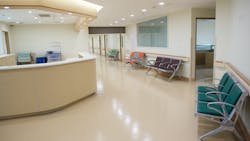Designing the dental practice of the future (pt. 1)
Style and trends aside, the design of the dental practice has remained fundamentally unchanged since its inception: a desk to check in, a chair for patient treatment, and necessary tools within reach. This is because dental care has been delivered in a surprisingly similar way for decades. COVID-19, however, has uncovered opportunities for traditional dental practice to improve, prompting designers and dentists alike to ask: What if? In this five-part series, we’re going to explore how the dental practice of the future can evolve to become safer, smarter, and more efficient.
New functional and psychological needs
As a health-care interior designer, my job is to respond to the needs of practitioners and the patients they serve. These needs have changed as we’ve learned to navigate practicing dentistry amidst a pandemic, and can be broken into two categories: functional needs and psychological needs. Functionally, there are new and modified activities that must take place, and heightened concerns about air quality and infection control. Patients must be screened, additional personal protective equipment (PPE) must be stored, donned, and doffed, and aerosol containment must be prioritized. Psychologically, patients and caregivers must feel safe in the practice environment. It should exude cleanliness and support physical distancing while maintaining an atmosphere that aligns with the practice’s values. Categorizing new needs in this way helps create guiding principles when embarking on space design. Design decisions should nurture both the functional and psychological needs of those using the space.
Hospital design best practices
Dental offices have always held themselves to high infection control standards, but new concerns about airborne infection transmission have emphasized the need. Governing authorities, such as the Centers for Disease Control and Prevention, have recommended changes to the physical practice environment through techniques such as engineering controls.1 While recommendations for dentistry are continuing to evolve, the industry can learn from design methodologies used in hospitals. Unlike dental offices, hospital facilities are subject to additional levels of approval to be granted a license to operate. While dental practices are not currently required to comply with hospital-level regulations, design techniques can be applied as best practices to enhance health, safety, and well-being. The following areas of focus keep this in mind.
Separation of three functional zones
The design of a dental office is what builds the foundation for efficiency and flow. When the layout supports the activities that take place within a practice, it creates ease of movement, reduces stress, and saves time. This is accomplished by organizing spaces into three functional zones: public, clinical, and team. The public zone is the front end of a practice where patients are greeted, checked in and out, and where business functions take place. The clinical zone is where treatment is provided and supported, consisting of operatories, consultation, sterilization, and laboratory. The team zone is where staff can decompress and recharge. While this approach to arranging spaces has been in practice for some time, a few enhancements can create an extra layer of infection prevention. When the separation of zones is more distinct, it becomes easier to avoid cross-contamination and implement engineering controls and air quality measures.
The public zone can be streamlined to avoid unnecessary interaction between patients. Plush seating and self-serve refreshment areas can be swapped for health-care-grade furnishings and impervious materials that are easy to clean. The clinical zone can be arranged to avoid bottlenecks by designating clear circulation paths and providing easy, in-and-out access to support spaces such as sterilization and clean supply storage. The team zone can be thoughtfully designed as an area of refuge for staff. Simple details such as personal storage lockers and clutter-free countertops can keep the space feeling less like an afterthought and more like a place to unwind.
Cleaner, safer clinical support spaces
Dental practices can learn a lot from hospitals when it comes to designing cleaner, safer support spaces. Based on function, hospital design categorizes support spaces as either “dirty” or “clean.” This dictates what should be clearly separated to avoid cross- contamination, and how air quality is addressed. If this logic is applied to the dental environment, sterilization and laboratories would be considered “dirty” spaces, along with soiled holding rooms, which are designed to safely store contaminated trash and PPE before disposal or laundering. In addition to being safely self-contained, “dirty” spaces should be designed with an air handling system that exhausts contaminated air directly outdoors or through a high-grade HEPA filtration system before it’s recirculated. Another solution is an air purification system like the EnviroKlenz Mobile Air unit. Clean supplies should be stored in designated “clean” areas, separated from potential sources of impurities, with an HVAC system designed to supply uncontaminated air. The same logic should apply to donning rooms, intended for the storage and application of clean PPE.
Operatories with aerosol considerations
The airborne nature of COVID-19 has dentists more concerned about aerosols than ever before. Luckily, innovative air quality products are quickly coming to the market, and there’s a growing body of resources that can help dentists understand their options. Air quality solutions can be paired with a practice’s design approach to enhance safety measures and provide peace of mind. There are three ways to approach air quality: isolation capture, which means sealing off a room and creating negative air pressure to contain and safely exhaust contaminants; ambient capture, which means utilizing centralized filtration systems to capture and clean air; and source capture, which means capturing contaminants at their source–near the oral cavity. Keep in mind that air quality is easiest to control in closed operatories, where contaminated air has less opportunity to travel before being effectively treated. In open treatment spaces, air quality techniques can be layered—for example, both source and ambient capture—for added protection. In either case, while COVID-19 is the first airborne infectious disease to shake up the field of dentistry, it likely won’t be the last. Air quality has been a priority in hospital settings for decades, and dental settings can benefit from prioritizing it as well.
Recommendations on the spectrum of safety
These recommendations, and those that will follow in more detail as part of this series, portray a spectrum of safety. Dental practice owners must decide where they fall along this spectrum and what solutions are right for them. While not required by regulatory agencies, they present opportunities for those looking to apply best practices. At the very least, it’s worthwhile to ask What if? when treatment planning the practice of the future.
Reference
1. Coronavirus disease 2019: Guidance for dental settings. Centers for Disease Prevention and Control. Updated August 28, 2020. https://www.cdc.gov/coronavirus/2019-ncov/hcp/dental-settings.html
Editor’s note: This is the first article in a five-part series. Look for part two in the December issue of Dental Economics.
Editor's note: This article is part one in a five-part series. Related articles can be found here:

